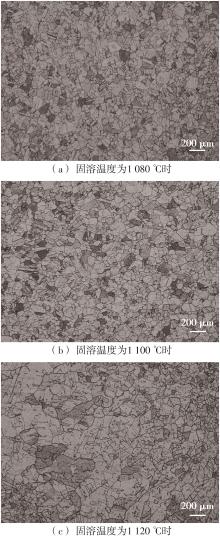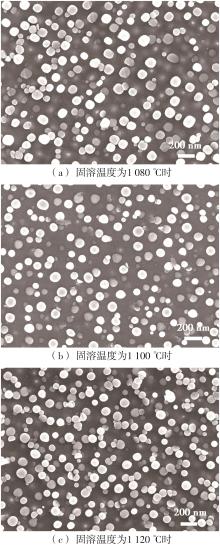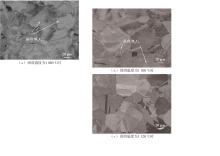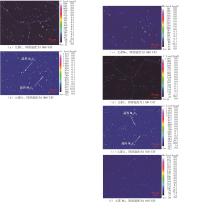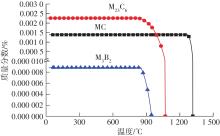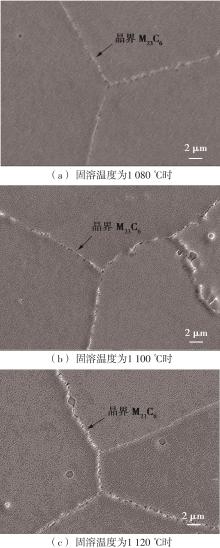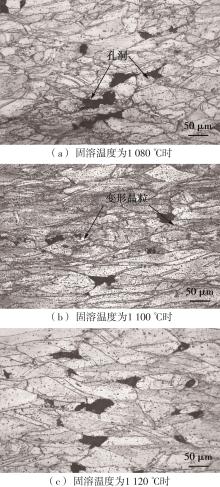Journal of South China University of Technology(Natural Science Edition) ›› 2022, Vol. 50 ›› Issue (8): 136-143.doi: 10.12141/j.issn.1000-565X.210704
Special Issue: 2022年材料科学与技术
• Materials Science & Technology • Previous Articles Next Articles
Influence of Solution Temperature on Microstructure and Mechanical Property of GH4099 Alloy
TAN Haibing1 LI Shu1 WANG Jing1 WANG Liangliang1 ZHU Changhong1 WANG Chong2 LIU Kangkang2 HUANG Shuo3 ZHONG Yan1
- 1.Sichuan Gas Turbine Establishment,Aero Engine Corporation of China,Chengdu 610500,Sichun,China
2.School of Materials Science and Engineering,Northeastern University,Shenyang 110819,Liaoning,China
3.High Temperature Materials Research Division,Central Iron & Steel Research Institute,Beijing 100081,China
-
Received:2021-11-09Online:2022-08-25Published:2022-03-25 -
Contact:黄烁(1988-),男,博士,高级工程师,主要从事变形高温合金新材料与新工艺研究。 E-mail:shuang@cisri.com.cn -
About author:谭海兵(1986-),男,高级工程师,主要从事新材料、新工艺的应用研究。E-mail:hibine. tan@163. com -
Supported by:the National Science and Technology Major Project(2017-VI-0015-0087)
CLC Number:
Cite this article
TAN Haibing, LI Shu, WANG Jing, et al. Influence of Solution Temperature on Microstructure and Mechanical Property of GH4099 Alloy[J]. Journal of South China University of Technology(Natural Science Edition), 2022, 50(8): 136-143.
share this article
| 1 | 何云华,喻桂英,曹令军,等 .GH99合金成分及热处理控制对性能的影响[J].特钢技术,1994(4):15-20. |
| HE Yunhua, YU Guiying, CAO Lingjun,et al .Effect of composition and heat treatment on properties of GH99 alloy[J].Special Steel Technology,1994(4):15-20. | |
| 2 | 魏育环,杨枬森,于万众,等 .GH99镍基合金长期时效后的组织和性能变化[J].钢铁研究学报,1988,1(4):33-40. |
| WEI Yuhuan, YANG Dansen, YU Wanzhong,et al .The change of microstructure and properties of GH99 alloy after long-term aging[J].Journal of Iron and Steel Research,1988,1(4):33-40. | |
| 3 | 李兴,陈礼清 .奥氏体化温度对Fe-17Mn-0.05C钢组织和拉伸性能的影响[J].东北大学学报(自然科学版),2017,38(8):1084-1087. |
| LI Xing, CHEN Liqing .Effect of austenitizing temperature on the microstructure and tensile properties of Fe-17Mn-0.05C steel[J].Journal of Northeastern University (Natural Science),2017,38(8):1084-1087. | |
| 4 | 黄慧强,邸洪双,张天宇,等 .两相区退火温度对高铝低硅TRIP钢组织和性能的影响[J].东北大学学报(自然科学版),2019,40(12):1700-1706. |
| HUANG Huiqiang, DI Hongshuang, ZHANG Tianyu,et al .Effect of intercritical annealing temperature on microstructure and mechanical property of high Al-low Si TRIP steel[J].Journal of Northeastern University (Natural Science),2019,40(12):1700-1706. | |
| 5 | SZCZOTOK A .Effect of two different solutionizing heat treatments on the microstructure of the CMSX-4 Ni-based superalloy[J].Solid State Phenomena,2016,246:15-18. |
| 6 | AI C, OU M Q, ZHAO X B,et al .Effect of heat treatment and long-term age on microstructure of a Ni3Al-based single crystal superalloy[J].Materials Research Innovations,2015,19:209-213. |
| 7 | XIANG W L, WANG L, LIU X G,et al .Effect of aging heat treatment on the microstructure and creep properties of the cast Ni-Based superalloy at low temperature[J].Acta Metallurgica Sinica,2019,32:651-658. |
| 8 | YIN F S, SUN X F, YUAN Cet al .Effect of heat treatment on microstructure and high temperature tensile pro-perties of cast nickel-base superalloy with high W, Mo and Nb contents[J].Transactions of Nonferrous Metals Society of China,2002,12:83-87. |
| 9 | YIN F S, SUN X F, YUAN C,et al .Effect of melt superheating on the morphology of MC carbide in a cast Ni-base superalloy M963[J].Journal of Wuhan University of Technology-Mater Sci Ed,2002,17(3):42-45. |
| 10 | ZHU Z Y, CHEN J H, CAI Y F,et al .Effect of heat treatment on the microstructure and fracture behaviors of a Ni-Cr-Fe superalloy[J].Materials Research Innovations,2020,22:109-114. |
| 11 | 王怀柳 .改善GH99合金板材力学性能的研究[J].特钢技术,2006,26(1):30-34. |
| WANG Huailiu .Study on improving mechanical pro-perties of GH99 alloy plate[J].Special Steel Techno-logy,2006,26(1):30-34. | |
| 12 | 王福 .高强度高塑性的GH99板材的热处理工艺与性能研究[J].特钢技术,2019,25(100):3-4. |
| WANG Fu .Study on heat treatment process and properties of GH99 plate with high strength and high plasticity[J].Special Steel Technology,2019,25(100):3-4. | |
| 13 | GUO B H, GUO X P .Effect of high temperature treatments on microstructure of Nb-Ti-Cr-Si based ultrahigh temperature alloy[J].Transactions of Nonferrous Me-tals Society of China,2011,21:1710-1716. |
| 14 | LIU C Z, LIU F, HUANG L,et al .Effect of hot extrusion and heat treatment on microstructure of nickel-base superalloy[J].Transactions of Nonferrous Me-tals Society of China,2014,24(8):2544-2553. |
| 15 | PAA-RAI C .Effect of double-step solution treatment on rejuvenation heat treated microstructure of IN-738 superalloy[J].Key Engineering Materials,2020,856:36-42. |
| 16 | WU H Y, ZHUANG X L, NIE Y,et al .Effect of heat treatment on mechanical property and microstructure of a powder metallurgy nickel-based superalloy[J].Mate-rials Science & Engineering A,2019,754:29-37. |
| 17 | ZHAO X B, DANG Y Y, YIN H F,et al .Effect of heat treatment on the microstructure of a Ni-Fe based superalloy for advanced ultra-supercritical power plant applications[J].Progress in Natural Science:Mate-rials International,2016,26(2):204-209. |
| 18 | J-H OH, I-C CHOI, KIM Y-J,et al .Variations in overall-and phase-hardness of a new Ni-based superalloy during isothermal aging[J].Materials Science & Engineering A,2011,528(19/20):6121-6127. |
| 19 | 张海南 .合金元素和固溶温度对GH99合金性能影响[J].上海钢研,1996(1):5-11. |
| ZHANG Hainan .The effects of alloying elements and solution-heat-treatment temperature on properties of GH99 alloy[J].Shanghai Iron and Steel Research,1996(1):5-11. | |
| 20 | 杨枬森,魏育环,宋诚一,等 .不同Al含量γ′相的反相畴界能及其对 GH99 镍基合金强度的贡献[J].金属学报,1986,22(6):477-483. |
| YANG Dansen, WEI Yuhuan, SONG Chengyi,et al .Inverse domain boundary energy of γ' phase with different Al content and its contribution to the strength of GH99 alloy[J].Acta Metall Sin,1986,22(6):477-483. | |
| 21 | 秦升学,王艳,张弘斌,等 .固溶处理对GH99合金组织的影响[J].金属热处理,2020,45(8):173-178. |
| QIN Shengxue, WANG Yan, ZHANG Hongbin,et al .Effect of solution treatment on Microstructure of GH99 alloy[J].Heat Treatment of Metals,2020,45(8):173-178. | |
| 22 | 秦升学,赵蕊蕊,张弘斌,等 .时效热处理对GH99中强化相γ′的影响[J].材料热处理学报,2017,38(2):55-60. |
| QIN Sheng-xue, ZHAO Rui-rui, ZHANG Hong-bin,et al .Effect of aging heat treatment on strengthening phase in GH99 γ′ Influence of[J].Transactions of Materials and Heat Treatment,2017,38(2):55-60. | |
| 23 | 向朝进 .弯曲晶界在Ni-Cr-W-Mo合金蠕变断裂中的行为研究[J].四川工业学院学报,1997,16(4):15-21. |
| XIANG Chaojin .Study on the behavior of curved grain boundary in creep fracture of Ni-Cr-W-Mo alloy[J].Journal of Sichuan University of Science and Techno-logy,1997,16(4):15-21. | |
| 24 | HE L Z, ZHENG Q, SUN X F,et al .M23C6 precipitation behavior in a Ni-base superalloy M963[J].Journal of Materials Science,2005,40(11):2959-2964. |
| [1] | ZHENG Lijuan, HU Zitao, LIU Shaofeng, et al. Preparation and Analysis of Laser Cladding Hard Coating on TC4 Surface [J]. Journal of South China University of Technology(Natural Science Edition), 2023, 51(6): 146-152. |
| [2] | ZHANG Heng, HUANG Junguang, LI Weike, et al. Influence of Electroosmosis-Calcium Chloride Treatment on the Deformation of Sodium Sulfate Saline Soil [J]. Journal of South China University of Technology(Natural Science Edition), 2023, 51(4): 53-60. |
| [3] | WANG Qingqing, LIU Zhanqiang, CHENG Yanhai, et al. Hardness Prediction of TC4 Machined Surface Based on the Evolution of Multi-scale Grain Refinement [J]. Journal of South China University of Technology(Natural Science Edition), 2023, 51(2): 35-46. |
| [4] | Yu Qijun, Ma Ting, Zhang Tongsheng, et al. Effect of particle size on hydration kinetics and microstructure development of recycled brick powder-cement pastes [J]. Journal of South China University of Technology(Natural Science Edition), 2023, 51(11): 63-73. |
| [5] | HU Songxi, FENG Yanhong, YIN Xiaochun, et al. Influence of Pulse Vibration Frequency on Structure and Properties of UHMWPE Molded by Pulse Vibration Molding [J]. Journal of South China University of Technology(Natural Science Edition), 2022, 50(8): 144-154. |
| [6] | LIAO Yanfen, QIU Mengze, CHEN Shunkai, et al . Experimental Study on Thermal Drying Characteristics and Pollutant Discharge Law of Municipal Sludge [J]. Journal of South China University of Technology(Natural Science Edition), 2022, 50(8): 92-101. |
| [7] | CHEN Weiping, LI Bing, LING Zicheng, et al. Influence of Ce Addition on Microstructure and Corrosion Resistance to Molten Aluminum of Fe-Cr-B Alloys [J]. Journal of South China University of Technology (Natural Science Edition), 2021, 49(9): 73-79. |
| [8] | YE Jun YE Fang XIONG Jian. Structure and Properties of Eu3+-Containing PVA/CMC Fluorescent Hydrogels [J]. Journal of South China University of Technology (Natural Science Edition), 2021, 49(9): 37-45. |
| [9] | WEI Xiaolan, LIN Guoqing, DING Jing, et al. Simulation and Experiment Investigation into Specific Heat Capacity Enhancement of Nitrate Molten Salt Nanofluid [J]. Journal of South China University of Technology (Natural Science Edition), 2021, 49(9): 46-55. |
| [10] | CAO Faxiang, KONG Jinxing, DU Dongxing. Research on Surface Properties of Nd: YAG Crystal Modified by Plasma Jet [J]. Journal of South China University of Technology (Natural Science Edition), 2021, 49(3): 55-61. |
| [11] | ZHOU Tao, HE Lin, TIAN Pengfei, et al. Prediction Model of Microstructure Evolution in Shear Zone During Cutting Process [J]. Journal of South China University of Technology (Natural Science Edition), 2021, 49(1): 82-92. |
| [12] | XU Daofen, CHEN Kanghua, XING Jun, et al. Microstructure and Corrosion Behavior of 2219 Aluminum Alloy Forging's Joint by TIG Welding [J]. Journal of South China University of Technology (Natural Science Edition), 2020, 48(3): 116-125. |
| [13] | YANG Shiyu, ZHAO Renda, JIN Hesong, et al. Analysis on Mechanical Properties and Fractal Characteristics of Micropore Structure of Geopolymer Mortar [J]. Journal of South China University of Technology (Natural Science Edition), 2020, 48(3): 126-135. |
| [14] | YE Jun FU Zichang XIONG Jian. Structure and Property Analysis of Fluorescent Films with CMC/Tb-Eu [J]. Journal of South China University of Technology (Natural Science Edition), 2019, 47(8): 113-119. |
| [15] |
YIN Xiaolong DENG Wenjun ZHANG Jiayang PI Yunyun .
Microstructure and Mechanical Properties of Al 7075 Alloy Prepared by Cryogenic-Temperature Extrusion Machining
|
| Viewed | ||||||
|
Full text |
|
|||||
|
Abstract |
|
|||||
